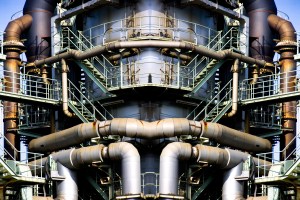 The Wall Street Journal has run a fascinating article about a newish travel trend in Japan called kojo moe – roughly translated as “factory love” or “factory infatuation.” Kojo moe enthusiasts fetishize the otherworldly beauty of elaborate industrial spaces: the steam punk drawbridge, the soft billows of a polluting smokestack emptying into an otherwise blue sky. Daisuke Wakabayashi reports that tourists young and old now board buses from Japan’s shinier cities and venture to industrial quarters to ooh and aah at the these sights, and with them, a breath of life, and hope, has returned to some down-and-out factory towns.
The Wall Street Journal has run a fascinating article about a newish travel trend in Japan called kojo moe – roughly translated as “factory love” or “factory infatuation.” Kojo moe enthusiasts fetishize the otherworldly beauty of elaborate industrial spaces: the steam punk drawbridge, the soft billows of a polluting smokestack emptying into an otherwise blue sky. Daisuke Wakabayashi reports that tourists young and old now board buses from Japan’s shinier cities and venture to industrial quarters to ooh and aah at the these sights, and with them, a breath of life, and hope, has returned to some down-and-out factory towns.
To wildly understate the obvious, weird trends are not exactly unusual in Japan. (Last March, the web site Japan Trends identified the kojo moe phenom.) It’s easy to chalk this aesthetic obsession up to the same stuff that has teenagers hiding behind flu masks or grocery stores running out of bananas.
But it’s not a coincidence that a group fixation on the mechanics of the fading industrial dominance of the nation started surfacing at nearly the same historical moment when Japan’s place as the world’s second largest economy was taken by its neighbor and rival China.
As my colleague Michael Schuman wrote last year, “the management practices of Japan’s biggest corporations — from ultra-efficient “just-in-time” manufacturing processes to consensus-based decisionmaking — were the envy of the world.” Today, Japan remains stuck in a holding pattern and cities like Yokkaichi (where the story is datelined) are stuck with the old problems of living next to big, sometimes deadly polluters while the rest of the country struggles to move in a new direction. (In 1970, a class action law suit was filed against Showa Yokkaichi Oil for burning oil and releasing severe smog that caused lung disease and a particularly nasty form of asthma now known as Yokkaichi asthma.)
Personally, I get the appeal of kojo moe. I grew up in a suburb of LA that was next door to a vast industrial swath of the city. Whenever we would drive by the white lights of one particular local oil refinery at night, my mother would whimsically call it the “fairy castle.” Around Halloween, Union Oil used to paint one of its huge storage drums like an enormous orange jack-o-lantern. We’d drive up and a Union Oil worker in coveralls would chuck a couple of plastic bags of caramel popcorn in the car.
Good times, but not kojo moe so much as making lemons from lemonade. I didn’t fully participate in industrial tourism ala Japan until I lived in Portland, Oregon, and took weekend trips out to the old lumber towns that were a few miles — and many world’s away — from the Pacific Northwestern capital of bike lanes and vegan diners. Wandering around the old mill towns, the heady smell of paper pulp in the air, imbued me with a sense of nostalgia for an Oregon that was already slipping through the fingers of history with every new organic supermarket that opened in the city nearby. Not that I ever knew that Oregon. If I did, I probably wouldn’t have been all that nostalgic for it; in 1929, the riverfront mills of Salem, Oregon, spewed an average of 1,400 tons of soot per square mile every year. Watching the white steam of the paper mill billow over Willamette River, I could witness the withering part of the state from the safe, cold distance of aesthetic appreciation – and at the end of the day, get back in my car, and leave.
It’s the reason why the residents of contracting factory towns in Japan are probably more than happy to capitalize on the hip, be-scarfed urbanites busing in from Tokyo to marvel at their smokestacks and drawbridges. But they will never understand them. Why should they? In a video posted online with the article, one kojo moe enthusiast says that watching the industrial spaces is “relaxing,” “soothing,” and “calming.” Probably not the exact words that come to mind for the residents of Yokkaichi who still suffer from asthma as a result of smog exposure forty years ago. You can call them fairy castles, or take your best shot of them with your Lomo app, but at the end of the day, working in and living near big industrial factories is not relaxing, or soothing, or anything even close. It just stinks.


